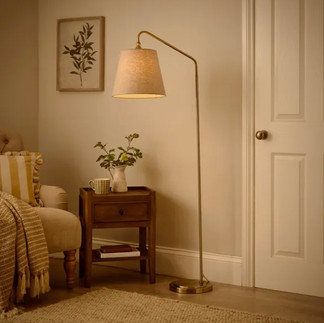How to Choose the Best Lighting for Every Room in Your Home
- Kimber Gray

- Feb 21
- 5 min read
Interior design lighting blog
Who doesn't love that cosy feeling you get when its dark outside and you walk into a softly lit room or see the dancing glow of a fire place or the soft light of a lamp and not want to curl up next to it with a good book. Thats how moving an experience lighting can be. Often overlooked or underestimated, lighting is a powerful tool at your disposal that can help transform the look and feel of your home, and by knowing a little about the different types of lighting and their purpose, you can achieve a lighting scheme that enhances the functionality of your space and more importantly, makes you feel at peace.
Different lighting types serve distinct purposes, whether it’s brightening up a workspace or creating a cozy atmosphere in a living room and in this guide, I have briefly covered the key categories of lighting: task, ambient, accent, and decorative lighting, so you can select the best options for each room in your home.
Understanding the Types of Lighting
To choose the best type of lighting for your home, it's essential to understand the four primary types of lighting: task, ambient, accent, and decorative. Each type plays a unique role in interior design and functionality.
Task Lighting provides direct illumination for specific activities. It's ideal for areas where concentration is needed, such as kitchens, offices, and reading nooks. Think desk lamps, under-cabinet lights, and pendant lights over work surfaces.
Ambient Lighting is the general illumination that fills a space. It provides a comfortable level of brightness, allowing you to see and move safely. Common sources include ceiling fixtures, chandeliers, and recessed lights. Ambient lighting acts as a foundation for layering other types of lighting.
Accent Lighting is used to highlight features or focal points within a room, like artwork, architectural elements, or plants. This could be achieved with track lighting, wall-mounted fixtures, or spotlights. Accent lighting adds depth and interest, creating visual appeal.
Decorative Lighting serves an aesthetic purpose, adding style and character to a room. This includes unique light fixtures such as sculptural chandeliers or beautifully designed lamps that complement your decor. While they may provide some illumination, their primary function is often visual enhancement.
Task Lighting: Enhancing Functionality in Service Areas
When deciding on task lighting, consider the activities that will take place in each area.
Kitchen
In the kitchen, focused lighting is essential for food preparation. Under-cabinet lights not only illuminate countertops but also create a warm, inviting atmosphere and pendant lights above a kitchen island can provide both style and function.

Corston - Bayliss spotlight Dunelm - Enid floor lamp Anglepoise - 1227 desk lamp
Home Office
For a home office, desk lamps with adjustable arms can provide targeted light, reducing eye strain during long working hours. Bright, white light bulbs can enhance concentration and productivity.
Reading Areas
In reading nooks, floor lamps with adjustable brightness levels offer versatility. Look for models that allow you to direct light towards your book or your workspace, ensuring comfort without glare.
Ambient Lighting: Setting the Overall Mood
Choosing the right ambient lighting can create a cohesive feeling throughout your home.
Living Room
In the living room, consider using a combination of a central ceiling fixture, such as a chandelier, with floor or table lamps for softer lighting. Dimmable switches can also allow for changes in mood, making the space versatile for different occasions.

Tiffany lighting direct - Endon Hansen wall light. Soho lighting - Glasshouse pendant Pooky - Phileas rechargable table lamp
Bedroom
In bedrooms, soft, warm ambient lighting is ideal for creating a relaxing atmosphere. Ceiling fixtures with fabric shades can diffuse light beautifully, while bedside lamps can provide the necessary light for late-night reading without disturbing your partner.
Hallways and Stairs
Here, ambient lighting plays a safety role. Use wall sconces or recessed lighting to prevent dark spots and ensure ease of movement.
Accent Lighting: Showcasing Style and Features
Accent lighting can transform an ordinary room into a visually engaging space by highlighting unique elements.
Artwork
To elevate artwork, use track lighting or picture lights designed specifically for this purpose. This not only draws attention to the art but adds an elegant touch to the decor.
Architectural Features
Architectural components like columns or alcoves can be stunning when accentuated with wall-mounted fixtures. This technique enhances the room’s design, giving it a more polished look.

Neptune - Athena uplighter National lighting - Yoker picture light Palefire - Satellite uplighter
Decorative Lighting: Adding Character
Understanding how to incorporate decorative lighting can elevate the overall aesthetic of your home.
Unique Fixtures
Incorporate statement fixtures such as a bold chandelier in the dining room or eye-catching pendant lights in the entryway. These can serve as conversation starters and central pieces in your decor.

Ralph Lauren - Hailee Chandelier Rothschild & Bickers - Pop petite wall light Lunara lights - Misterlamp
Layering Styles
Mixing different styles and types of decorative lighting can add depth and personality. For example, using modern fixtures alongside vintage lamps can create a distinctive and inviting ambiance.
Tips for Choosing the Best Lighting
Consider the Purpose: Identifying the activities that will occur in each room will help guide your lighting choices. We all know how frustrating it can be when squinting to see things in badly lit areas or having to walk somewhere else to get better lighting so make sure to understand all the tasks you will undertake in each room to be able to make informed lighting choices.
Layer Your Lighting: Combine all four lighting types to create a well-lit, visually interesting space. I cant stress enough that layering is one of my biggest tools in design and is often where interiors fall short. Adding layers of light, texture or colour will really help to give dimension and life to your space.
Experiment with Dimmers: This allows for flexibility in mood and functionality, ideal for both lively gatherings and quiet evenings and don't forget to use the light switches as another opportunity to enhance the scheme. Did you know you can get perspex switch plates now to allow the colour to show through? Great for those wanting switches to be invisible rather than making them a statement with metal finishes.
Match Your Style: Choose fixtures that blend with your decor and reflect your personal aesthetic. Don't be afraid to mix vintage and modern by keeping a reoccurring element in all the lighting such as colour, material or form.
Think About Maintenance: Consider the type of bulbs you choose and how easy they are to replace or adjust. Energy saving bulbs are important for sustainability and saving money so always check what bulbs your new lighting takes.
Selecting the best lighting for every room in your home involves understanding the 4 main types: task, ambient, accent, and decorative and each category plays a crucial role in enhancing functionality, atmosphere, and style. By carefully considering the purpose of each space, mixing various lighting types, and matching your choices with your overall decor, you can create an interior lighting scheme that will improve your home and impress your guests and who doesn't love a little excuse for an interiors related shopping trip! So have a look at your lighting situation and let me know in the comments if you are now planning to update your lighting scheme. Happy light sourcing loves.
Kimber Gray
Interior Designer


























Comments